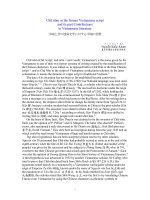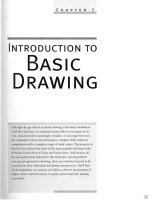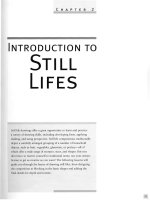AESTHETIC REALISM, ART, and ANTHROPOLOGY: Or, JUSTICE to PEOPLE pot
Bạn đang xem bản rút gọn của tài liệu. Xem và tải ngay bản đầy đủ của tài liệu tại đây (487.17 KB, 13 trang )
Page 1
AESTHETIC REALISM, ART, and ANTHROPOLOGY: Or, JUSTICE to PEOPLE
By Marcia Rackow and Arnold Perey, Ph.D.
Published in
International Conversations through Art
:
Proceedings of the 31st InSEA World Congress 2002
Prabha Sahasrabudhe, Editor
Center for International Art Education
Teachers College Columbia University, New York: 2003
We are very proud to present today what we have learned from the philosophy Aesthetic
Realism about what beauty is—and why this explanation is needed by the world for people to be
just to one another at last.
This landmark principle, "All beauty is a making one of opposites, and the making one of
opposites is what we are going after in ourselves," was stated by Eli Siegel, the American poet,
critic, and educator, who founded Aesthetic Realism. It is the basis of the museum art and
anthropology classes we teach together. And this principle, we've seen, is the means for people
to have large emotions from the art of every continent—including styles unfamiliar to them—
and to see people of other cultures with authentic depth and kindness.
Our students were deeply moved, as we were, for example, by a bronze flutist from
Benin, Nigeria; a Haida mask of western Canada; a Mayan god of Central America—as we saw
how in the very purpose and structure of art, such opposites as sameness and difference, surface
and depth, the intimate and the wide, hard and soft are made one. And these are the very same
opposites we are trying to put together in ourselves. Through the opposites, we see our true
kinship to peoples far away in place and time.
We are Marcia Rackow, an artist, and Arnold Perey, an anthropologist, and are
consultants on the faculty of the Aesthetic Realism Foundation. Both of us are honored to have
studied with Mr. Siegel whose centenary is being celebrated this year, including in Baltimore,
MD where he grew up. His birthday, August 16
th
, was designated "Eli Siegel Day" by the mayor
and by the governor. We're proud to study now in classes taught by Ellen Reiss, the Class
Chairman of Aesthetic Realism. We have seen in the fields of the visual arts and anthropology
that the understanding Aesthetic Realism provides enables a person to see freshly, vividly, and
with great respect the beauty of reality—and of mind in people different from oneself in skin
tone, religion, and language. Nothing is more necessary today.
Art has stood for the best in humanity because it is impelled by the deepest purpose in
every human being, which Aesthetic Realism describes:
to like the world on an honest or
accurate basis.
The greatest opposition in people to the justice art stands for is
contempt
—defined by
Mr. Siegel as “the disposition in every person to think he will be for himself by making less of
the outside world." Contempt for the world and people is ordinary and everyday—as when one
person feels
"I know better than that person does,"
and corrects, scornfully, the statement of
Page 2
another—or looks down on someone's taste in books or clothing—or is lonely because people
are not good enough for oneself. But contempt, taken very far, Eli Siegel showed, is the cause of
racism, unjust economics, war. Two crucial forms of contempt we speak of in this paper are (1)
for the world itself,
and (2)
not seeing other people's feelings as real.
For, "as soon as you have
contempt," Mr. Siegel wrote, "as soon as you don't want to see another person as having the
fulness that you have, you can rob that person, hurt that person, kill that person" (
James and the
Children: A Consideration of Henry James's
The Turn of the Screw, p. 55).
People of different races, religions, nationalities, are closer together worldwide than ever.
And yet the desire to understand one another is desperately lacking. Aesthetic Realism can
change this, as we will see. It makes clear how
aesthetics fully understood
is
the
opponent to
cruelty and racism.
It is our firm belief that through the Aesthetic Realism understanding of art and self, we
can have a world in which beauty is respected and people see each other fairly.
We begin now with art of the Inuit.
The Inuit (Formerly Eskimo)
Inuit Masks, Alaska
The Inuit people live in the arctic region of North America. They are people confined for
months in shelters during the long Arctic winter, when it is dark both day and night. With vast
stretches of snow and ice reaching to the horizon in every direction, the men would go hunting
on long treks alone, not returning home for days or weeks. In their art, the Inuit are impelled to
make sense of this being confined and going out, this feeling of being far away, and coming back
in to the center. The masks of the Inuit—going as far back as there is any record and in
settlements across thousands of miles of territory—often powerfully show the meaning of these
opposites:
center
and
circumference
,
within
and
without
.
These opposites are at the basis of life for everyone, for we all see ourselves as the center
Page 3
of a universe with infinite circumference. "We all of us begin with a
here,
" wrote Eli Siegel,
ever so snug and ever so immediate. And this
here
is surrounded strangely, endlessly, by
a
there
. We are always meeting this
there:
in other words, we are always meeting what is
not ourselves, and we have to do something about it. We have to be ourselves, and give
to this great and diversified
there,
which is not ourselves, what it deserves. This means
we have to be personal and impersonal, snug and exterior. If we do this successfully,
whether we know it or not, we have arrived at a beauty which is efficient; at aesthetic
good sense. [
Self and World,
p.91]
There is a conflict, a struggle in everyone between these two directions. One solution is
to try to put aside reality: have contempt for it. Two very common ways people have contempt
are: We can either fight with the world aggressively or run away from it into a world of our own
that is more comforting. “Everybody,” wrote Mr. Siegel, “is to a degree icebound, and crippled,
and stuck, and jammed, and shut in….What is it for a person to be free?” People of the arctic,
like people outside the arctic, have not known entirely what it is to be free. For example, there is
what is called Arctic Hysteria, or in Inuit,
pibloktok.
Described for more than a century,
pibloktok
can include breaking out through the wall of an igloo into the snow and ice, “tearing
off clothing,” as Edward F. Foulks reports, “fleeing across the tundra,” “rolling in the snow,” and
threatening or hurting a person. (See
The Arctic Hysterias,
pp. 18, 13.)
It is important to see that this way of meeting a seemingly forbidding world with
terrifying and hurtful contempt is opposed in the art of the Inuit. In our classes we have
discussed works like the Inuit mask from Alaska we show now:
Page 4
Inuit Mask, Kuskoskwim River, Alaska
Painted Wood, Feathers, and Leather, 45 ½ High
Discussion of the Opposites in an Inuit Mask
The mask is a surprising and wonderful relation of
center
and
circumference,
of
containment
and
freely going forth,
giving it a vibrant sense of life. Its intense, terrified and also
sad expression seems to withdraw inward into the purity and whiteness of self while feathers,
hands, fins, seal flippers, spindles, circles radiate, almost explode from its enclosed central form.
Jutting out from around the top of the head are white feathers and extending behind them is an
arched reed that forms a wider oval. Then thrusting forth from the center of that worried
forehead are circles and fish-like pendants. Partly hidden but protruding from the center of the
forehead is a small carved human figure. What a drama of center and circumference!
The crescent-shaped eyes curve up, giving the face an expression of fear. The broad,
gently curved nose with its flaring nostrils add to that feeling, while the wide open mouth,
curved up, is a mingling of grin and grimace with teeth sticking out. There is a surprising
relation of a fearful
inwardness
in the eyes, with the broad,
outward
expression of the mouth.
Like the Inuit, I [Marcia Rackow] had too a drive towards hiddenness and secrecy. In an
Page 5
Aesthetic Realism class Mr. Siegel explained what I and many people have gone for: “You get a
value out of thinking you are secret and immune. The question is: How much do you want to be
in relation to things not yourself and to the world?” This is a question for every person, whether
on a frozen tundra, a Brooklyn street, or a university classroom.
One of the most moving aspects of the mask are the two curved hands which reach out
from the sides, as though from the depths within. The gracefully curved fingers give the hands a
yearning quality, a desire to embrace what is around it. They are painted red with scattered white
dots, relating them to the blue areas around the mouth. Then, like the hands, coming out of the
sides of the chin are two flipper-like forms. And at the center of the chin another form juts out
like a seal or fish tail with spindles hanging from it.
The mask joins many things—earth, sky and sea, and it shows a person's relation to other
beings—in fact, it is a composition of seal, human, fish, and bird. “Finding relations among
discordant things,” Mr. Siegel said in a lecture on Hieronymus Bosch, “has been an instinct; it
has also been a method in art The tendency to these combinations does exist, and present day
art is in the midst of that tendency: to make the world even more coherent by being more
audacious and finding that in discord there isn’t as much discord as one thought at first a desire
of man is to put some harmony into a discordant world.”
So this mask does something very important—not only for the Inuit carver and the people
for whom he made it—it gives form to, and resolves that fight in every person
between one’s
exclusive, enclosed, separate self,
and
the self in relation to a wide and unknown world.
And as we see how the Inuit artist successfully makes a one of opposites that fight in our
own lives, we understand ourselves better and we respect that artist and his culture more deeply.
Native Americans of the Northwest Coast—and Sameness and Difference
(From Classes Given at the American Museum of Natural History, New York City)
South of the Inuit are the Native American tribes of the north Pacific coast, both in the
United States and Canada. Their traditional way of life, now gone, was described by Ruth
Benedict as dramatic, economically wealthy, and rich in art—but competitive. It was a society in
which there were sharp divisions between nobles, commoners, and slaves. The ownership of the
goods of the earth was drastically unequal. And even amongst themselves the nobles fought for
status.
Difference
was accentuated.
Franz Boas, who lived amongst them as the 20
th
century began, tells of “pompous
speeches” made by high status individuals; their “treating inferiors with the greatest
arrogance”—and with a “disdainful manner” (pp. 459-61).
In reading about the people of the NW Coast, I [Arnold Perey] felt, as everyone feels
who reads about them, that something in me was being described.
In an Aesthetic Realism class, Eli Siegel asked me, “Are you more interested in being
better than other people, or as good as you can be?” Like so many other human beings across the
Page 6
globe I was more interested in being better than other people and this made me unjust. From
early childhood I cultivated the glory of feeling I and my family were superior to the rest of
humanity. I was to learn from Aesthetic Realism that this way of seeing people—and the world
itself—was contempt, and not glory at all. It hurt my life and was the very thing that made me
dislike myself
.
Today, when there is tremendous prejudice among persons of different religions, races,
nations, and also great economic injustice
—
and there are horrors going on in the world as a
result of these, including the Middle East, it is of the utmost urgency to understand contempt and
oppose it.
When a person in any culture has contempt, the opposites of
difference
and
sameness
are
seen in a terrible, false way: one looks down on others and does not see how they are LIKE
oneself. And this makes oneself feel bad. Native Americans of the Northwest Coast are
described as swinging from arrogance to self-abasement: "from triumph to shame" (Ruth
Benedict,
Patterns of Culture,
p. 220). This is how I felt. It is a notable fact that people of the
Northwest coast came to an art form that criticizes what they were doing as a society, and as
people
.
They created a design which, Franz Boas tells, they used “everywhere”—democratically,
showing the
sameness
within difference.
The most striking decorative form which is used almost every where, consists of a round
or oval field, the “eye design.” This pattern is commonly so placed that it corresponds to
the location of a joint Often the oval is developed in the form of a face. [P. 252]
Things are not only different, the artist is saying, they are the same, too!—and more than
you thought! We see this oneness of difference and sameness in a Sun Mask from this region
now.
Page 7
Kwakiutl Sun Mask, Northwest Coast of North America, Fort Rupert
Collected by George Hunt, 1897, Wood, Height, 55 cm, Width, 62 cm.
How Sameness and Difference Are One in Kwakiutl Art
In his historic 15 Questions, “Is Beauty the Making One of Opposites?” Eli Siegel asks
this about the opposites of Sameness and Difference:
Does every work of art show the kinship to be found in objects and all realities?—and at
the same time the subtle and tremendous difference, the drama of otherness, that one can
find among the things of the world?
The mask, which represents the sun, has a human face in the center with five radiating
panels representing the sun’s rays. They also represent two bird’s heads in profile, flippers, and a
dorsal fin on top. (See Franz Boas’
Primitive Art,
pp. 233, 253, 238-9.) In all the rays, that
classic eye-shape appears, bringing surprising unity to the composition.
And what makes the mask so vibrant is the intense color—a dramatic and rich interplay
Page 8
of warm reds, contrasting cool blues, and blacks—with touches of the warm brown wood.
The forms are abstract, yet we see a living being present. He looks up expectantly and
somewhat fearfully as his eyes are surrounded in a blue mask-like form, with wide black bands
above forming the eyebrows. The eyes are beautifully, sensitively carved and seem to emerge
from the soft flesh of the lids which have a very sharp, exact edge.
Why does he have this disagreeable expression? He does not like the world—has too
much contempt. Looking at the mask upside down, what do we see?—another very different
living thing—which is smiling! On this upside-down mask we actually see three faces, one
above the other, totem-pole fashion. The art of this region often shows how interested the people
are in the opposites of above and below, and we believe is a criticism of how their whole society
was based on rigid boundaries between people of higher class and lower class—very much like
our own society. It is against the false way a person makes himself different from anyone else in
order to feel superior.
Often one feels the artist is having fun with the forms, and brings humor to something
which socially can be grim and unjust.
In his essay “Individuality As Aesthetic Sameness and Difference," Mr. Siegel explains
what this beautiful Kwakiutl mask shows and what every person hopes to feel:
A self yearns, pines, longs—dramatic verbs!—to be like other things. The self has a lust
for multitudinous identification This difference and sameness in self, Aesthetic
Realism maintains, is like the beginning of art. The beginning of art—to be found in
reality—is the awful and sweet and constant and surprising and shocking difference and
sameness of things.
Seeing the Kwakiutl artist trying to be just to
sameness and difference,
makes us want to
be just to people ourselves!
We will now speak of two crucial opposites:
The Opposites of Beauty and Ugliness
One of the most important things we learned about the meaning of primitive art is that it
deals with, and answers in a way crucial for every person, the biggest question in the world—
how to see the relation of beauty and ugliness. In a lecture on sculpture, Eli Siegel described the
impact of primitive art on modern art as “the incursion of the ugly.” This is a work by Mark Di
Suvero. “Primitive art,” Mr. Siegel said, “has this great depth; and it made the ugly part of art,
because since the 1920's it was felt that sculpture could be distorted, could be grotesque.”
How do we see the ugly, the unlikable? What can we learn from the art of many cultures
about how to see what we don’t like or are afraid of? In classes on tribal sculpture, we have
looked at works from North America and South America—a South American mask is illustrated
here; Oceania—a mask from Melanesia is illustrated; and Africa—an African mask is also
illustrated. Mr. Siegel explained:
The lines, the masses, the directions, what are called the volumes, and so on, are arranged
Page 9
a certain way, and they show man’s attitude to the god he felt was in the sky, in the
water, in the forest, in himself.
And people today, in this turbulent world, as in tribal times, see the world as governed by
forces one cannot control which are large and often seem irrational. “The artist,” writes Lydie
Krestovsky in her book
La Laideur dans l'Art
, (
Ugliness in Art
across the Ages, 1947)
“stands in
the center of a combat participated in by Divinity and man.” She continues:
In order to express plastically this drama of fear before the entire divine power shapes
exaggeratedly accentuated had to be used and more than human forms, neighboring life
had to be found. The concrete had to be used to symbolize the terror of man before
supernatural powers.
Commenting on this passage in his lecture from which we just quoted, Mr. Siegel noted
that the tribal artists saw
beauty
, or
form,
in the world whose cause they fought against, feared,
and loved. He said:
They tried to represent the ugliness
and the beauty,
the grotesqueness
and the form
of the
god or the world that they saw. [Emphases added]
Melanesia Africa South America
These sculptures seem to say: With all the ugliness that can be—disease, floods,
droughts, and human cruelty—there is grandeur in the world I can respect and care for. Today,
with acts of terrorism, war, and with disease of epidemic proportions in Africa
the question
implied by art, and asked by Aesthetic Realism is more urgent than ever:
Is this true: No matter how much of a case one has against the world—its unkindness, its
disorder, its ugliness, its meaninglessness—one has to do all one can to like it, or one will
weaken oneself? [
The Right Of,
no. 703]
Is this the purpose of the tribal artist as he gives form to what is ugly? We think it is.
Page 10
Tongue-thrusting Sculpture of the Maori, New Zealand
To give form to the ugly, the unbearable, is to be
for
the world while being
against
what
is hurtful in it.
Here is a Polynesian work of the Maori of New Zealand. It is a study in intensity and
calm form—opposites every person is concerned with. The spirit is thrusting its tongue. Says
Alfred C. Haddon in
Evolution in Art,
“The human tongue, which, when thrust forth to its utmost
conveys, according to Maori ideas, the most bitter insult and defiance.”
In this work, as in the art of the Maori often, there is a giving form to contempt—a
depiction of the ugly that makes for beauty. This menacing being stares out at us with glaring
Page 11
round abalone eyes and mouth open in a snarl, showing its teeth and the large tongue thrust out so
intensely it covers the chin.
Yet with all the intensity of the emotion, the figure is given a strict, symmetrical form. It
is a severe, rectangular shape with a head as large as the torso, supported on short, stocky legs.
The arms, held close to the sides, terminate in hands that join at the fingertips, appearing rather
meek, even as they accent the rectangle. The feet, too, accent this regular, geometric shape.
Within the severity of the form, the body is decorated in swirling patterns and angular chevrons.
The nose, formed of curving shapes comes to a sharp, hooked point.
Does this stand for a fight in every self between contempt and respect, our wanting to
stick our tongues out at the world, defy it, and wanting to be pleased by it? In an Aesthetic
Realism class, I, Marcia Rackow, learned about this fight in myself. Mr. Siegel explained, “You
would like to be sweet and show how kind you are and also be strong and show no one can take
advantage of you.” Here the ferociousness of this being is made one with graceful form.
The Human Face—Or, Seeing People Justly
We have learned that the way to know a person fully, is to see that person aesthetically:
as trying to put opposites together.
The opposites of the world are in us and relate us to everyone and everything else. We
have in us the Energy and Repose of reality—a reality with volcanoes and quiet, moonlit lakes.
We are Center and Circumference like the solar system, pulled toward the sun yet circling in
space. We have Concentration and Expansion like an egg with a chick in it, about to hatch out.
We are a study in Sameness and Difference like a snowflake, a six-pointed star like all the others
yet different from every other flake.
“To know a person,” Mr. Siegel writes, “is to know the universe become throbbingly
specific. It is always the universe on two feet, with two eyes, and an articulate mouth” (Preface
to “The Ordinary Doom,"
Frances Sanders Lesson,
p. 36).
Page 12
Ife, “Head with Flared Hairdress” [probably 11-14th c.]
Terracotta, Traces of Red Pigment, from Aba Ayinkinni, Oshishoko, Height, 7 in., Africa
As we look at this sublime work of some thousand years ago, we see a rigid ceramic:
terracotta. Yet the lips seem as tender as a mother's lips today. The opposites of
hard
and
soft
were made one by the artist.
Don't we need to see people are trying to put these opposites together in themselves, to be
fair to them? Men have seen women as soft, as comforts against a cold world, but need to see a
woman as logical, practical, determined, also, in order to be fair to her. A woman often sees a
man as only tough and unfeeling. That he may also be unsure, wants to be kind, as well—she
needs to see, in order to be fair. We need to see what is beneath the surface.
For example, the curving parallel lines incised in the skin of the portraits of Ife, including
this beautiful head, imply that there is depth to this surface, something is beneath this. Does this
show there is something within this person that deserves to be seen. Isn't this how a person wants
to be understood—as surface and depth at once? We can never be fair to a person until we see
Page 13
their feelings are real, their depths: what goes on inside them—their pleasures and pains, their
hopes and fears—are as real and as worthy of respect as our own. The artist conveys, through the
rough terracotta of this head, depth of emotion—a person looking into the distance and affected
by what she sees—the figure seems about to draw breath, about to speak. Depth and surface are
one: the fact that the headdress is drawn tight and goes out implies there is thought that is within
and goes forth. Emotion is present together with a lovely face.
The greatest question for the world today is this, asked by Mr. Siegel: "What does a
person deserve by being alive?" Aesthetic Realism itself shows that being seen the art way or
aesthetic way is what every person deserves. This includes an understanding of the human desire
for contempt, which has for so many centuries caused injustice and brutality. The aesthetic way
of seeing people is what can replace racism and prejudice with justice. It is what can make for
economic fairness to every person. The Aesthetic Realism understanding of art and people is
urgently needed. We are proud to be presenting it today.
Bibliography of Works Cited
Baird, Martha and Ellen Reiss, ed.
The Williams-Siegel Documentary: Including Williams' Poetry Talked about by
Eli Siegel, and William Carlos Williams Present and Talking: 1952,
NY: Definition Press, 1970.
Benedict, Ruth.
Patterns of Culture,
NY: Sentry, 1934.
Boas, Franz. “Social Life.” In
General Anthropology,
NY: D.C. Heath, 1938.
_________.
Primitive Art,
NY: Dover, 1955.
Boas, Franz, and George Hunt. “Kwakiutl Texts.”
Publications of the Jessup North Pacific Expedition 3,
1905.
Bunzel, Ruth. “Economic Organization of Primitive Peoples,”
General Anthropology,
Franz Boas, ed., NY: Heath,
1938.
Foulks, Edward F.
The Arctic Hysterias of the North Alaskan Eskimo,
in
Anthropological Studies,
David H.
Maybury Lewis, ed., American Anthropological Association, Washington, D.C.: 1972.
Freuchen, Dagmar, ed.
Peter Freuchen's Book of the Eskimos,
Cleveland and New York: World Publishing, 1961
.
Haddon, Alfred C.
Evolution in Art,
London: Walter Scott, 1895.
Ife Head.
Head with Flared Hairdress.
Probably 11-14th century A.D. In Lagos National Museum, Lagos, Nigeria.
Inuit Mask. Kuskoskwim River Alaska. In Metropolitan Museum of Art, N.Y.
Kwakiutl Sun Mask, Collected by George Hunt, 1897. In American Museum of Natural History, N.Y.
Siegel, Eli.
Is Beauty the Making One of Opposites?
, NY: Terrain Gallery, 1955. Reprinted in
Journal of Aesthetics
and Art Criticism,
December 1955.
________.
Aesthetic Realism As Beauty: Sculpture,
unpublished lecture, N.Y.: Aesthetic Realism Foundation, 1951.
________.
James and the Children: A Consideration of Henry James’s
The Turn of the Screw, NY: Definition
Press, 1968.
________.
The Frances Sanders Lesson and Two Related Works,
NY: Definition Press, 1974.
________.
Self and World: An Explanation of Aesthetic Realism,
NY: Definition Press, 1981.
________. “Individuality As Aesthetic Sameness and Difference." In
The Right of Aesthetic Realism to Be Known,
no. 649, 11 September 1985
________. "An Aesthetic Realism Manifesto about Education." In
The Right of Aesthetic Realism to Be Known
, no.
703, 24 September 1986.









